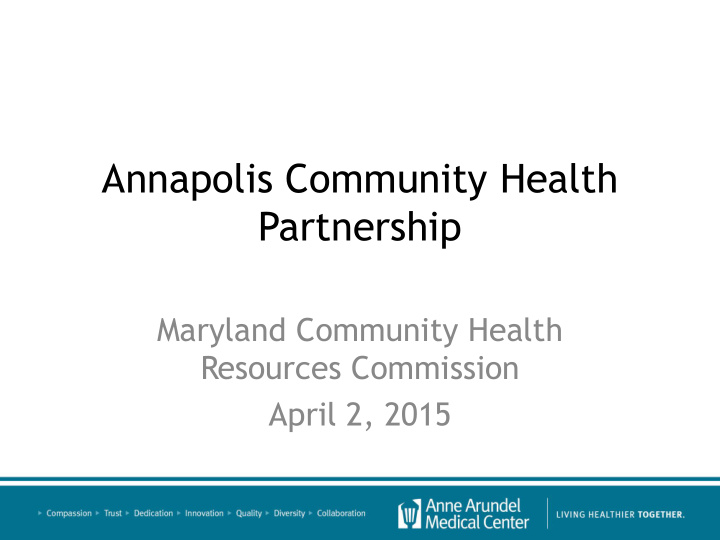



Annapolis Community Health Partnership Maryland Community Health Resources Commission April 2, 2015
ACHP • Collaboration between Anne Arundel Medical Center (AAMC) and Housing Authority of the City of Annapolis (HACA) • Insertion of a community health resource in a public housing unit (“MB”) to serve residents and the surrounding community – Primary care medical services at reduced cost – Navigational services at no cost: care coordination, coaching, education, advice and support
ACHP Structure • One medical practice , < 1,000 sq feet: – MD – RN Care Coordinator – Office assistant/medical assistant (bilingual) • Many partners: – HACA congregant program, AAMC care management and social work, contracted CHWs, AskAAMC, behavioral health resources, medical specialist community • Infrastructure : AAMC’s integrated electronic medical record
What ACHP Has Accomplished • Expanded and Filled Service Capacity – Provided direct primary care services to 1,119 unduplicated patients since opening in October 2013 – Engaged >50% of MB residents in direct primary care services, provided navigational services to many more • Assured Quality of Care – Reduced medical 911 calls, ED visits, admissions and readmissions from MB
More stats: ALL MB RESIDENTS (not necessarily ACHP patients) MB Opened in October 2013 1/1/13 - 7/1/13 - 1/1/14 – 7/1/14- 6/30/13 12/31/13 6/30/14 12/31/14 Readmission 11 14 6 1 Events Admission 49 47 37 26 Events n/a 103 87 88 ED visits Medical 911 n/a 87 111 83 calls
Lessons Learned Since Opening • Navigational services are at least as important as medical services in reducing preventable utilization. • Longitudinal relationships allow us to move from crisis intervention to prevention and self-management . • Building trust requires tolerance, respect, perseverance and listening .
Getting Insurance Coverage or Access to Care Does Not Confer Instant Health Literacy • Tales from the frontline: – The newly insured – The new immigrant – The new entrant to primary care
ACHP’s Year 3 Work Plan: Consolidating and Building Upon Early Success • Reduce prevalence of risk factors for developing chronic disease, and reduce the risk of complications in those with chronic disease • Increase community resources for health • Reduce preventable ED visits and hospitalizations • Reduce unnecessary costs in healthcare
1)Reduce risk factors for chronic disease and risk for complications of chronic disease • 100% of patients age > 18 screened for tobacco use. – Improve provision of interventions for those screening positive by 20% • 100% of patients age >12 screened for depression – Improve provision of interventions for those screening positive by 20% • 100% of patients age >18 screened for abnormal BMI – Improve provision of interventions for those screening positive by 20%
Risk Factor Reduction, cont’d • Improve control (<140/90) of blood pressure in hypertensive patients age 18-85 by 20% • Reduce by 20% the percentage of diabetics age 18-75 with A1C > 9.0 • Improve by 20% the percentage of diabetics with an annual retinopathy screen. • Improve by 20% the percentage of diabetics with an annual foot exam.
How ACHP Will Accomplish This • EMR workflow and tools – Point-of-care reminders – Population registries and dashboards • Patient outreach and follow up – Interventions provided at clinic – Interventions provided by network of community specialists, educators, peer-to- peer coaching
2) Increase Community Resources for Health • Provide diabetes self-management workshops to at least 20 high-risk patients • Provide COPD self-management workshops to at least 20 high-risk patients • Provide one-on-one coaching to at least 10 individuals seeking help to cease tobacco consumption • Implement Referrals for Recovery (RforR) to ensure timely evaluation for those with urgent need for behavioral health services
How ACHP Will Accomplish This • AAMC nurses have been trained to lead diabetes workshops • AAMC respiratory therapists and pharmacists will lead the COPD workshop • AAMC cancer prevention specialists will provide one-on-one coaching on site. • Funding has been provided to implement RforR, a program that involves a network of 6 behavioral health providers .
3) Continue to Reduce Preventable ED Visits and Hospitalizations • Implement program of identifying “medically homeless” individuals in the ED and referring them to MB for care. • Implement changes in hours of operation at MB clinic to better meet population needs
How ACHP Will Accomplish This • Engage ED care managers and staff as well as key community specialty providers to refer “medically homeless” patients to MB, particularly those who are uninsured, underinsured and/or Spanish-speaking. • Examine volume patterns of demand, no-show rates and walk-ins to determine what change of hours would optimize utilization.
4) Reduce Unnecessary Costs in Healthcare • Perform quarterly assessment of ED visits by MB residents to assess reasons for visit. • Promote use of the MB clinic for services that can easily be performed there.
How ACHP Will Accomplish This • Configure report from hospital warehouse data that blindly lists “reason for visit” of patients from address of MB. • Review report to determine which types of ailments could have been addressed at MB (e.g. UTI, cerumen impaction, COPD exacerbation). • Use local marketing in 3 new ways to increase awareness and promote use of the clinic as an alternative to the ED.
Projected Year 3 Budget Expenditures • Total annual HEZ funding to ACHP is $200,000. This offsets the physician’s salary and fringe benefits. • Remaining costs of staffing, medical supplies and equipment, vaccines, office supplies and equipment, management, communication hardware, EMR, et cetera are covered by AAMC.
ACHP Partnerships and Opportunities • Faith-based Community • Behavioral Health – Arundel Lodge – Other behavioral health providers • Private Donations – Individual – Corporate, e.g. Charm City Run • External Funding Partnerships – Stulman Foundation – Pending Grants
“The power of community to create health is far greater than any physician, clinic or hospital.” Mark Hyman
Recommend
More recommend